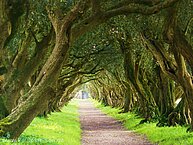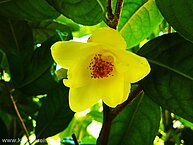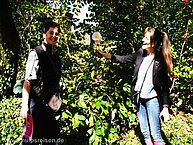Services
• 6 x nights in double room with bathroom
• 6 x breakfast
• 2 x wine tasting
• 1 x farewell dinner
• English, German, and Spanish speaking tour guide
• all entry fees and guided walks through the gardens
• transfers as described (max. one piece of luggage à 15kg and one daypack)
Camellias of Galicia
Guided garden tour at the sea
Spring in Galicia. While gardens in other parts of Europe still hibernate, Galician gardens develop their greatest blooming season. Azaleas, acacias, eucalyptus, gorse, magnolias, camellias, and callas. Everywhere, it's blooming colorfully! We visit Galicia's most beautiful mansions, stroll through extensive parks, and try the delicious seafood and wines, always following the „Road of the Camellias“.
Itinerary
Day 1 Individual arrival to Galicia
Individual arrival to Santiago de Compostela or Vigo. Your tour guide welcomes you and picks you up from the airport. Transfer to our beautiful country house in Cambados, a picturesque seaside village, where we reside for the next three days. The country house is a mansion from the 15th century with a flourishing garden.
Day 2 Camellias between vineyards and sea
Transfer from our accommodation to the Pazo de Rubianes, an elegant country estate surrounded by extensive vineyards and centuries-old camellias in all colors: yellow, white, fuchsia, and red. The jewel of the collection is the famous variety "Eugenia de Montijo," named after a red-haired Empress, who was born in Granada in the midst of an earthquake. Her name, the epitome of the color red, perfectly reflects this Camellia variety. We round off our first guided garden visit with a wine tasting in an elegant atmosphere. We stop for lunch on the peninsula O Grove before walking through a dune landscape with pristine beaches and bizarrely shaped granite boulders. In the evening, we stroll through the medieval alleys of Cambados with its magnificent patrician houses and exquisite wine shops and restaurants.
Day 3 Romantic gardens
In the morning, we visit the Pazo de la Saleta. In 1968, Margaret and Robert Gimpson, an English couple with a green thumb, came to Galicia to devoted themselves to the garden of A Saleta. They brought some new camellia varieties to Galicia. Over time, more than 200 camellia varieties have moved into the garden. Secluded bypaths and an elegant neglect give a typical English flair to this garden. Afterwards, we visit Combarro, a charming fishing village, known for its typical corn storages, which are situated in first row to the sea. We have lunch in a restaurant with sea view, then we walk through the winding old town. In the shadow of the medieval fortress Castelo de Soutomaior, camellias unite with roses, and scents melt with colors. The park houses the largest camellia trees of Galicia. More than a hundred camellias varieties and ancient chestnuts from five continents thrive along with palm trees, orange trees, eucalyptus, and magnolias.
Day 4 Gold of the sea
When the morning tide is going out, we have an appointment with the President of the Mariscadoras of Cambados. She provides us with boots, because our visit will take us to the tidelands, where about fifty to eighty women, armed with rakes and buckets, carry out their work. They are clam collectors, who explain their work to us. They harvest the "gold of the sea". In the afternoon, we stroll through the romantic park of the Pazo Quinteiro da Cruz, manor house and winery, which houses a collection of unique and rare camellias, such as the huge fuchsia-yellow-blooming Camellia „Happy Higo“. Spain's kings have been supplied from the wine cellar of the Pazo. The venerable walls of the winery are the perfect place for our wine tasting. In the early evening, we head towards Santiago de Compostela, where we will be staying the next three days in a cozy B&B in the heart of the old town.
Day 5 Galician horticulture and ancient olive tree avenues
We visit the oldest noble country estate of Galicia. In the garden of the Pazo de Oca, a network of canals and granite water basins runs through the ample parkway with its mysterious character full of eucalyptus and magnolias. 277 white camellias lead to "Captain Rawes", one of Europe's oldest camellias (13 meters tall). The park of the manor Pazo de Ribadulla houses the largest collection of camellias in Galicia with more than 500 camellia varieties. What a flowerage! We walk on the Paseo de Olivos, an avenue lined by over 300 years old, gnarled olive trees, that lead us back to the mansion. In the afternoon, you have time to explore Santiago more in detail. For example the romantic old alleys, a tour over the rooftops of the Cathedral, or a visit to the modern City of Culture designed by the American architect Peter Eisenman.
Day 6 On poetic paths
In the morning you have free time, for example, to stroll through the vivid farmer's market of Santiago, where the local farmers sell meat, fish and seafood, fruits, vegetables and flowers. You will see older market women carrying their wares in large wicker baskets on their heads to the marketplace, just like a hundred years ago. Afterwards, we go to Padrón to visit the former cottage of Rosalía de Castro, the Spanish Emily Dickinson. Unrecognized during her lifetime and after her death almost forgotten, she was being rediscovered in the early 20th century. Her modern and open poetries paved the way for modernity. The Galicians revere her work in the Galician language very much, for she was the first writer, who dared to write poetry in this disesteemed language! In the small romantic garden around the cottage, camellias receive us in a lyrical atmosphere. The old ombú with its huge trunk patiently watches the comings and goings of the visitors. In the evening, we enjoy a farewell dinner in a selected restaurant in Santiago's old town, where we will be spoiled with dishes of modern Galician cuisine.
Day 7 Good-bye, Galicia
After breakfast, transfer to the airports of Santiago or Vigo. Then, individual departure or you extend your stay, for example, at Casa do Torno, a cozy country house on the Galician coast.


Also read or see:
—› "Camellia - Flower of Galicia"
A travel report on our garden tour to the camellias in February 2013.
—› "On the Route of the Camellias"
A newspaper article about our garden tour to the camellias published by the Austrian weekly magazine "Die ganze Woche" (February 2014).
















































